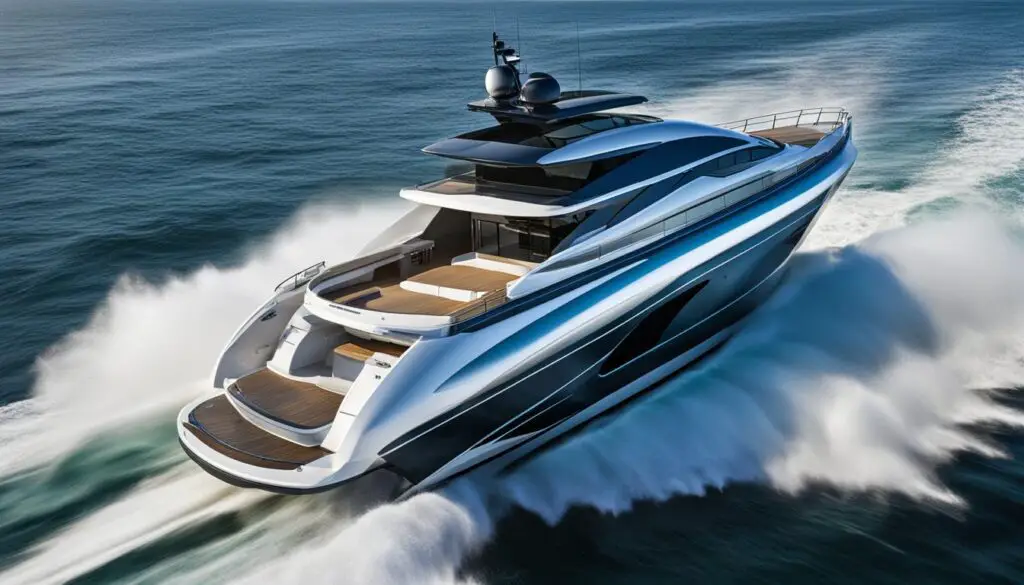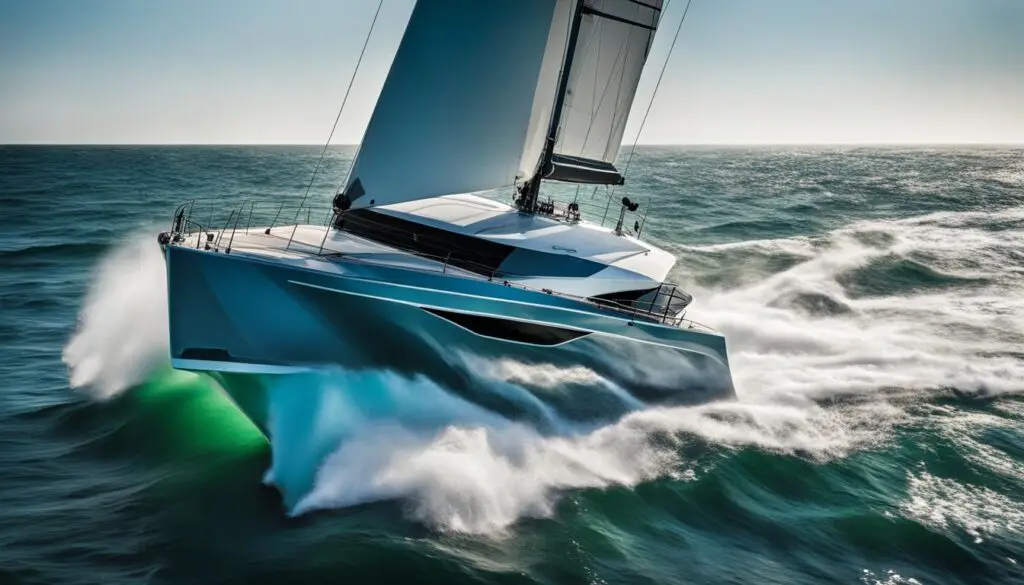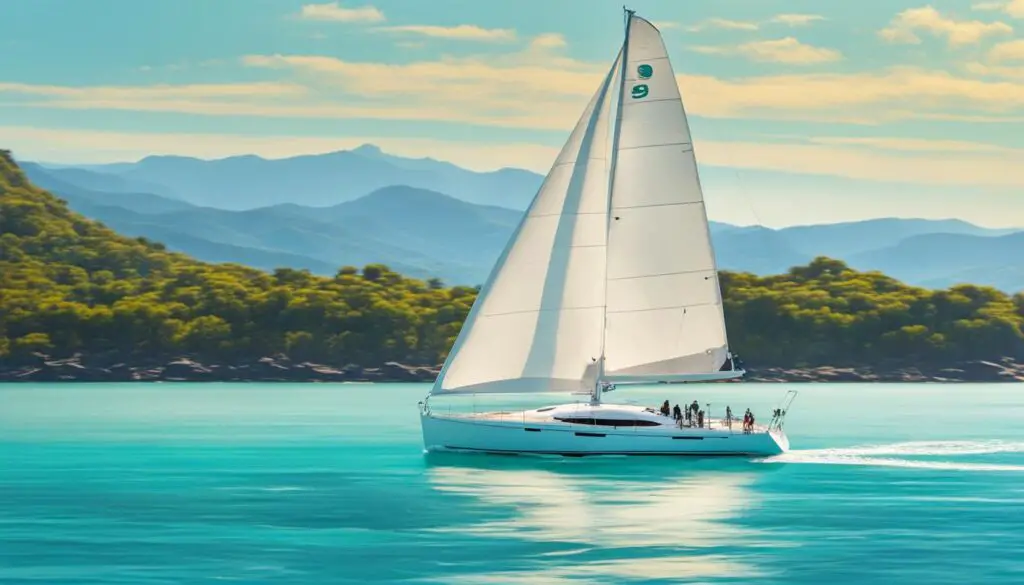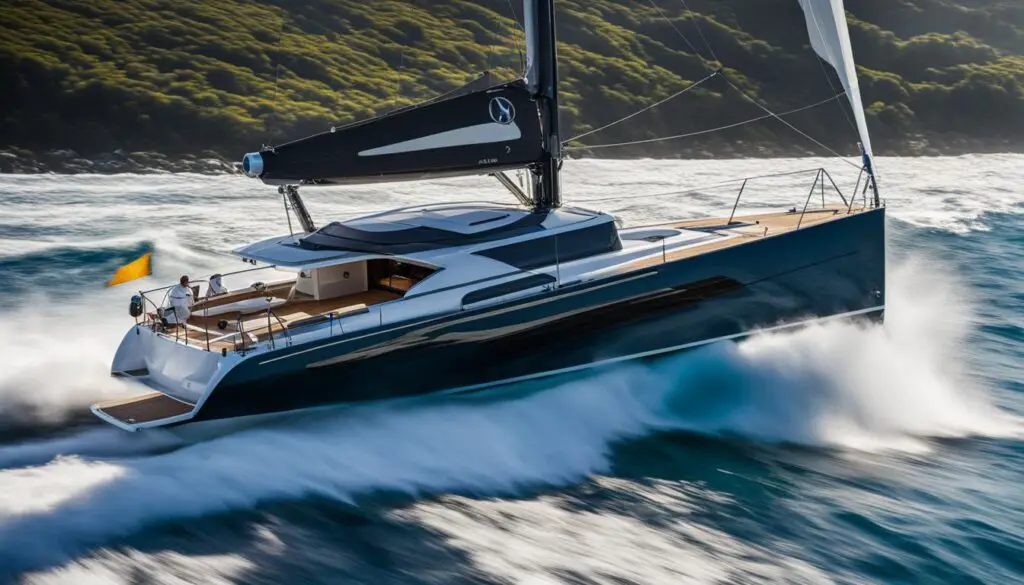Have you ever wondered how fast yachts can go? Whether you’re a seasoned sailor or a curious enthusiast, understanding yacht speed is essential for optimizing your boating experience. Yachts come in various types and sizes, each with its own unique speed capabilities. From high-speed racing yachts to leisurely cruisers, the speed of a yacht can vary significantly.
So, how fast do yachts actually go? Let’s dive in and explore the fascinating world of yacht speeds. From the top speed of yachts to average cruising speeds, we’ll uncover the factors that influence their performance and the limits of their capabilities.
Key Takeaways:
- The speed of a yacht depends on its type, with different types of yachts having varying speed capabilities.
- Pontoons are the fastest type of yacht, reaching speeds of up to 30 mph.
- Cruisers, deck boats, and sailboats have average speeds ranging from 10 to 23 mph.
- Factors such as yacht design, hull type, boat length, wind conditions, and sail balance influence a yacht’s speed.
- Racing yachts can achieve remarkable speeds, with some reaching up to 65.45 knots (75 mph).
Types of Yachts and their Speeds
Yachts come in various types and sizes, catering to different preferences and needs. From mini yachts with a length of 23 feet to superyachts with a length of at least 78 feet, there is a yacht for every enthusiast. Each type of yacht offers unique features and capabilities, including varying speeds.
Let’s take a closer look:
Pontoons
Pontoons are renowned for their impressive speed capabilities. These yachts, featuring flat decks mounted on pontoons or flotation devices, can reach speeds of up to 30 mph (miles per hour). Offering stability and ample space for leisure activities, pontoons are a popular choice for those seeking high-speed adventures on the water.
Cruisers and Deck Boats
Cruisers and deck boats strike a balance between speed and comfort. With an average speed of 23 mph, these yachts provide a smooth and enjoyable cruising experience. Cruisers are designed for long trips and overnight stays, while deck boats offer ample deck space for outdoor activities and socializing.
Sailboats
Sailboats, powered by the wind, offer a serene and eco-friendly sailing experience. While they may not match the speed of powerboats, sailboats provide a unique connection with the water and the elements. With an average speed of 10 mph, sailboats allow for leisurely exploration and a slower pace of navigation.
In summary, the type of yacht you choose will determine the speed capabilities it offers. Pontoons excel in high speeds, cruisers and deck boats provide a comfortable cruising experience, and sailboats offer a leisurely and eco-friendly navigation. Consider your preferences and desired activities on the water when selecting the right yacht for you.
Factors Affecting Yacht Speed
When it comes to yacht speed, several factors come into play. Understanding these factors can help yacht owners and enthusiasts determine the optimal performance of their vessels. Let’s explore some of the key elements that influence yacht speed:
Yacht Design and Hull Type
The design and hull type of a yacht play a crucial role in determining its speed capabilities. Displacement hulls, commonly found in monohull sailboats, are designed to cut through the water smoothly. This design is ideal for stable and comfortable cruising at moderate speeds. On the other hand, planing hulls can achieve faster speeds as they ride on top of the water, creating lift and reducing drag.
Length of the Boat
The length of a yacht also affects its speed. In general, longer boats tend to be faster due to their increased waterline length. The longer the yacht, the greater its potential speed. This is because longer waterline lengths allow for smoother passage through the water, reducing resistance and increasing efficiency.
Wind Conditions and Current
Wind conditions and the presence of current can have a significant impact on a yacht’s speed. Favorable wind conditions can provide an additional boost to a yacht’s speed, allowing it to harness the power of the wind for increased performance. Conversely, adverse wind conditions can hinder a yacht’s speed. Additionally, the presence of current can either enhance or impede a yacht’s progress, depending on its direction and strength.

“The design and hull type of a yacht, the length of the boat, and the wind conditions and current all contribute to the overall speed and performance of the vessel.”
By considering these factors, yacht owners can make informed decisions about their vessel’s design, structural elements, and the optimal sailing conditions for maximum speed and performance.
Hull Speed and Its Limitations
In the world of yachting, hull speed is a term that refers to the maximum speed that a displacement hull yacht can achieve based on its waterline length. Each yacht has its own unique hull speed, and it can be calculated using a simple formula: 1.34 multiplied by the square root of the waterline length.
Once a yacht reaches its hull speed, further acceleration becomes inefficient and requires significantly more energy. This is because the yacht’s displacement hull is designed to cut through the water, creating waves that move in sync with the boat’s speed. When the yacht reaches its hull speed, the waves become larger and the boat must push through them, resulting in increased resistance.
However, it’s worth noting that planing hull yachts have a different design and can exceed their hull speed by riding on top of the water. Planing hulls are typically found in high-speed yachts and allow them to achieve faster speeds by lifting the hull out of the water. This reduces the resistance and allows the yacht to glide over the water’s surface.
While planing hulls offer greater speed capabilities, displacement hulls have their own advantages. They provide a stable and comfortable ride, making them ideal for long-distance cruising and ocean crossings. Additionally, displacement hulls are more fuel-efficient at lower speeds, making them a popular choice for many yacht enthusiasts.
Sailing Speed and Wind Power
Sailboats harness the power of the wind to generate impressive speed on the water. The size of the sail area is a critical factor in determining a sailboat’s velocity, as it directly affects the amount of wind captured and converted into forward motion. Increasing the sail area can enhance power and speed, but it also poses challenges in terms of boat control and stability.
To optimize both speed and control, achieving the right balance of sail area is essential. This involves carefully assessing the sailboat’s design, weight distribution, and rigging to ensure that the sail’s size is proportionate to the boat’s overall structure. Achieving the ideal sail balance allows for efficient power transfer, enabling the boat to harness the wind’s force effectively.
Wind conditions and the direction of the wind also significantly impact a sailboat’s speed. In general, sailboats experience faster speeds when sailing downwind, as the wind blows directly from behind, pushing the boat forward. This enables the sailboat to utilize the full force of the wind, resulting in increased velocity.
| Factors influencing sailboat speed: | Effects on sailboat speed: |
|---|---|
| Size of sail area | Influences power and speed |
| Sail balance | Optimizes control and efficiency |
| Wind conditions | Impact speed, with downwind enabling faster speeds |
To illustrate the influence of sail area on sailboat speed, consider the following scenario: A sailboat with a larger sail area will typically generate more power and achieve higher speeds compared to a boat with a smaller sail area. However, larger sails may make the sailboat more challenging to handle and require more advanced sailing skills.

It’s important for sailors to strike the right balance between power and control to optimize their sailing experience. By considering factors such as sail area, sail balance, and wind conditions, sailors can enjoy exhilarating speeds while maintaining a safe and enjoyable journey on the water.
Determining Average Sailing Speed
When it comes to sailboats, determining the average sailing speed is an essential factor to consider. The average sailing speed of a sailboat typically ranges from 4-6 knots (4.5-7 mph). Larger racing yachts can reach speeds of up to 15 knots (17 mph). Knowing the cruising speed of your sailboat allows you to plan your journey and estimate the time it will take to reach your destination.
One way to calculate sailboat speed is by measuring the distance traveled over a specific time. For example, if a sailboat covers a distance of 100 nautical miles (115 miles or 185 km) in one day at an average speed of 4.5 knots, the sailing speed can be determined by dividing the distance traveled by the time taken. With this calculation, you can estimate the sailing speed in nautical miles per hour (knots) for your specific voyage.
The average sailing speed may vary depending on wind conditions, currents, and the size of the sailboat. It’s important to consider these factors when planning your sailing trip to ensure a smooth and enjoyable journey.
Overcoming Hull Speed with Surfing Conditions
Displacement hull sailboats are known for their limitations in speed due to hull speed. However, there are certain conditions in which these sailboats can exceed their speed limits. These conditions, known as surfing conditions, occur when a sailboat is sailing downwind with a favorable current that helps the boat overtake its own bow wave.
During surfing conditions, sailboats experience a temporary increase in speed, albeit not significant, typically around 1 knot. It’s important to note that achieving surfing conditions requires specific wind and current conditions to be met.
Wave Cycles and Displacement Hull
The concept of surfing conditions relates to the interaction between the sailboat’s hull and the waves it creates. Displacement hull sailboats are designed to move through the water, which creates a series of waves. As the sailboat approaches hull speed, the wavelength of these waves lengthens, making it difficult for the sailboat to climb over them efficiently.
However, in the right conditions, a favorable current can assist the sailboat in overcoming these limitations. The boat “surfs” down the face of the wave, riding on top of the water instead of plowing through it.
Benefits and Limitations of Surfing Conditions
While surfing conditions can provide a temporary boost in speed, it’s important to understand their limitations. The increase in speed achieved during surfing conditions is typically modest, and it might not be a sustainable speed for extended periods. Additionally, achieving surfing conditions requires a specific combination of wind direction, current strength, and wave patterns, which can be unpredictable.
Nevertheless, experienced sailors can take advantage of surfing conditions to optimize their sailboat’s performance, making sailing more enjoyable and efficient.
| Advantages | Limitations |
|---|---|
| – Temporary speed boost | – Modest increase in speed |
| – Enhances sailboat performance | – Limited sustainability for extended periods |
| – Thrilling sailing experience | – Dependent on specific wind and current conditions |
Sailboat Speed Under Power
Sailboats have the flexibility of being powered by engines when sailing at low speeds or when maneuvering in and out of ports. The sail-and-power combination allows sailors to maintain a suitable speed and control the boat in different situations.
The average speed of a sailboat under power is around 4-5 knots (5 mph). When the sailing speed drops below 6 knots, most sailors switch to the engine to ensure consistent progress. This average speed under power allows for efficient navigation while preserving fuel and ensuring a comfortable yachting experience.
Having the capability to switch between sail and engine power provides versatility during different weather conditions, currents, or when navigating in smaller waterways.
By utilizing the engine and sail in combination, sailors can maintain a steady speed and adapt to changing conditions effectively. This combination ensures a balance between power and efficiency, allowing sailors to reach their destinations safely and comfortably.
While sailboats are renowned for their ability to harness the power of the wind, having an engine for propulsion offers greater control and maneuverability when needed. It allows sailors to navigate tight spaces, come into harbor smoothly, and tackle adverse conditions when wind power alone is insufficient.
In situations where sailboats need to maintain a constant speed or overcome unfavorable wind conditions, relying on engine power provides stability and increases overall efficiency. This sail-and-power combination enables sailors to optimize their yachting experience and ensures that they can enjoy their time on the water while maintaining a suitable speed.

Advantages of Sailboat Speed Under Power:
- Enhanced control and maneuverability
- Ability to navigate in tight spaces
- Greater stability in adverse weather conditions
- Consistent speed even when wind power is inadequate
- Efficient fuel management and reduced environmental impact
By combining the power of the engine with the sailing capabilities of a sailboat, yachtsmen can optimize their yachting experience, ensuring a reliable and enjoyable journey on the water.
Speed Records and Racing Yachts
Racing yachts are engineered for ultimate speed, pushing the boundaries of yachting performance. These high-speed racing yachts have set impressive speed records, showcasing their exceptional capabilities and the skills of the sailors. With advanced design technologies and cutting-edge features, these racing yachts have achieved remarkable speeds that leave spectators in awe.
Some of the fastest yachts in the world can reach speeds ranging from 30 to 50 knots (35 to 58 mph), surpassing the limits of traditional sailing vessels. In fact, the current yacht speed record stands at an astounding 65.45 knots (75 mph), a testament to the incredible capabilities of these high-performance machines.
These racing yachts utilize planing hulls, which allow them to ride on top of the water rather than cutting through it. The sleek and streamlined designs, coupled with lightweight materials, reduce drag and maximize speed. Every aspect of these yachts, from the sails to the rigging, is optimized for high-speed performance, ensuring that they can harness the power of the wind to its fullest potential.
Speed records in sailing competitions are not only a display of pure speed but also a reflection of the ingenuity and innovation driving yacht design. These records push the limits of what is possible in the world of yachting, inspiring further advancements and breakthroughs.

As sailing enthusiasts marvel at the top speed achievements of racing yachts, it’s important to remember that speed is just one aspect of the yachting experience. Safety, comfort, and efficiency also play vital roles in a satisfying and enjoyable voyage. Whether you’re racing in a competitive regatta or cruising leisurely, finding the perfect balance between performance and practicality is key.
Optimal Yachting Experience and Efficiency
When it comes to yachting, prioritizing sailing comfort and efficiency can greatly enhance your experience on the water. By maintaining the optimum sail balance and employing effective handling techniques, you can ensure a smoother and more efficient ride.
One important aspect of sailing comfort is keeping the boat balanced. Sailing at an optimal heel angle of 15° allows the yacht to maintain stability and reduces the risk of excessive rolling. This not only enhances comfort but also improves overall sailing efficiency.
To achieve the right balance, it is crucial to consider the weather helm of the boat. Weather helm refers to the slight pressure on the helm that helps the yacht maintain its course. By adjusting the sails and rudder, you can achieve a weather helm of 2-4°, which provides the perfect balance of control and performance.
Reefing, or reducing sail area, is another important technique that enhances both safety and efficiency. It involves reducing the size of the sails to maintain control and stability during strong winds or rough conditions. By reefing the sails, you can prevent excessive heeling, maintain optimum speed, and ensure a safer and more enjoyable yachting experience.
Take a look at the diagram below for a visual representation of the optimum sail balance and reefing techniques:
By prioritizing sailing comfort, efficiency, and yacht handling techniques such as maintaining optimum sail balance and reefing when necessary, you can create an optimal yachting experience that combines both performance and enjoyment.
Conclusion
Understanding the factors that influence yacht speed is essential for yacht enthusiasts and sailors alike. From the hull type and boat length to wind conditions and sail balance, these variables play a crucial role in determining the cruising and maximum speeds of a yacht.
Sailboats, in particular, rely on the power of the wind and the optimum balance of their sails to achieve efficient speed. Sail design and balance are of utmost importance as they directly impact the yacht’s performance on the water. Finding the right balance of sail area ensures both speed and control, enhancing the overall sailing experience.
While racing yachts are renowned for their remarkable speeds, it is important to prioritize safety, comfort, and efficiency when engaging in recreational yachting. Understanding yacht speed factors allows sailors to fine-tune their sailing experience and optimize performance on the water, creating a satisfying and memorable yachting adventure.
FAQ
How fast do yachts go?
The speed of a yacht can vary depending on its type. Pontoons are the fastest, reaching speeds of up to 30 mph. Cruisers and deck boats have an average speed of 23 mph, while sailboats typically have an average speed of 10 mph.
What is the maximum speed of a small yacht?
The maximum speed of a small yacht is around 60 km/h.
How fast can racing yachts go?
Some specialized racing yachts can reach speeds of up to 60 knots (around 69 mph).
What factors affect yacht speed?
Several factors can influence the speed of a yacht, including its design, hull type, length, wind conditions, and the presence of current.
What is hull speed?
Hull speed refers to the maximum speed that a displacement hull yacht can achieve based on its waterline length.
How are sailboats powered?
Sailboats rely on wind power to generate speed, but they can also use engines when sailing at low speeds or maneuvering in and out of ports.
How do wind conditions affect sailboat speed?
Wind conditions and the direction of the wind can impact a sailboat’s speed, with downwind conditions usually allowing for faster speeds.
How is sailboat speed calculated?
Sailboat speed is typically measured in knots, with 1 knot equal to 1 nautical mile per hour. The speed can be calculated by dividing the distance traveled by the time taken.
Can sailboats exceed their hull speed?
While planing hull yachts can exceed their hull speed by riding on top of the water, displacement hull yachts have limitations due to the physics of wave cycles. However, they can temporarily exceed their hull speed in certain conditions called surfing conditions.
How fast can sailboats go under power?
The average speed of a sailboat under power is around 4-5 knots (approximately 5 mph).
What are some notable speed records achieved by racing yachts?
The current speed record in sailing competitions is 65.45 knots (approximately 75 mph), showcasing the high-speed capabilities of racing yachts.
How can one ensure an optimal yachting experience?
To have an optimal yachting experience, it is important to prioritize sailing comfort and efficiency. This includes maintaining a balanced boat, achieving the right sail balance, and practicing reefing when necessary.

